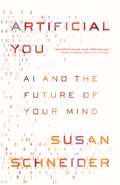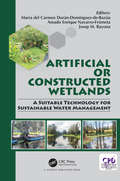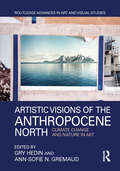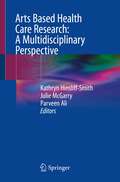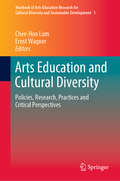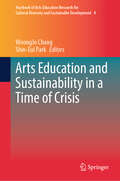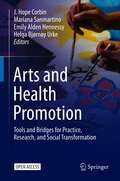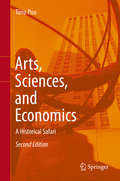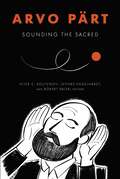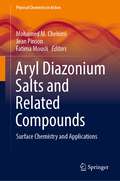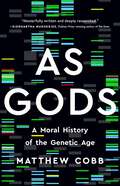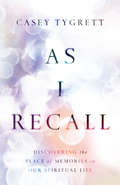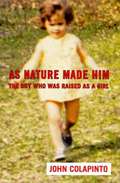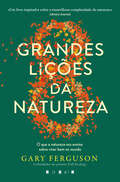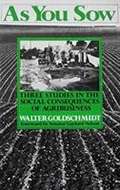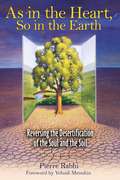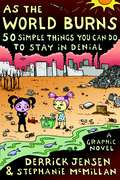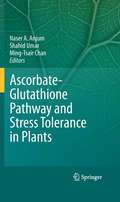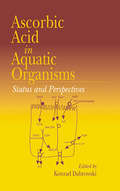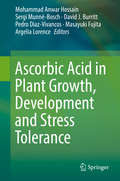- Table View
- List View
Artificial You: AI and the Future of Your Mind
by Susan SchneiderA sober-minded philosophical exploration of what AI can and cannot achieveHumans may not be Earth’s most intelligent beings for much longer: the world champions of chess, Go, and Jeopardy! are now all AIs. Given the rapid pace of progress in AI, many predict that it could advance to human-level intelligence within the next several decades. From there, it could quickly outpace human intelligence. What do these developments mean for the future of the mind?In Artificial You, Susan Schneider says that it is inevitable that AI will take intelligence in new directions, but urges that it is up to us to carve out a sensible path forward. As AI technology turns inward, reshaping the brain, as well as outward, potentially creating machine minds, it is crucial to beware. Homo sapiens, as mind designers, will be playing with "tools" they do not understand how to use: the self, the mind, and consciousness. Schneider argues that an insufficient grasp of the nature of these entities could undermine the use of AI and brain enhancement technology, bringing about the demise or suffering of conscious beings. To flourish, we must grasp the philosophical issues lying beneath the algorithms.At the heart of her exploration is a sober-minded discussion of what AI can truly achieve: Can robots really be conscious? Can we merge with AI, as tech leaders like Elon Musk and Ray Kurzweil suggest? Is the mind just a program? Examining these thorny issues, Schneider proposes ways we can test for machine consciousness, questions whether consciousness is an unavoidable byproduct of sophisticated intelligence, and considers the overall dangers of creating machine minds.
Artificial or Constructed Wetlands: A Suitable Technology for Sustainable Water Management
by María del Durán-Domínguez-de-Bazúa Amado Enrique Navarro-Frómeta Josep M. BayonaArtificial or constructed wetlands are an emerging technology particularly for tropical areas with water scarcity. For big cities, the sustainable management of water resources taking into account proper use is always challenging. The book presents case studies illustrating the above. As plants and microorganisms are a fundamental part of the correct functioning of these systems, their contribution to the degradation of the organic matter and to the removal and transformation of the pollutant compounds present in the wastewaters is also a highlight of this book.
Artificially Controllable Nanodevices Constructed by DNA Origami Technology: Photofunctionalization and Single-Molecule Analysis (Springer Theses)
by Yangyang YangIn this book, the author deals mainly with two topics: (1) single-molecule visualization of switching behaviors in the DNA nanoframe system utilizing different kinds of molecular switches through the use of high-speed atomic force microscope (AFM); (2) construction of photocontrollable DNA nanostructures in programmed patterns and direct visualization of the dynamic assembling process. Here, high-speed AFM was employed to observe the dynamic movements of single molecules. Compared to a traditional single-molecule analysis method, such as fluorescence spectroscopy or electron microscopy, high-speed AFM makes possible the real-time observation of molecule behaviors. DNA nanostructures were designed and assembled as scaffolds to incorporate interested biomolecules. The observations were carried out under robust conditions without complicated pretreatment. Moreover, the photoresponsive molecules were successfully assembled into around 100 nm-sized DNA nanostructures. The assembly/disassembly of nanostructures can be regulated reversibly by photoirradiation. This book explains how DNA origami has gradually become a useful tool for the investigation of biochemical interactions in defined nanospace. It also shows the possibility of DNA nanostructures acting as nanodevices for application in biological systems, serving as a good introduction to basic DNA nanotechnology.
Artistic Visions of the Anthropocene North: Climate Change and Nature in Art (Routledge Advances in Art and Visual Studies)
by Gry Hedin Ann-Sofie N. GremaudIn the era of the Anthropocene, artists and scientists are facing a new paradigm in their attempts to represent nature. Seven chapters, which focus on art from 1780 to the present that engages with Nordic landscapes, argue that a number of artists in this period work in the intersection between art, science, and media technologies to examine the human impact on these landscapes and question the blurred boundaries between nature and the human. Canadian artists such as Lawren Harris and Geronimo Inutiq are considered alongside artists from Scandinavia and Iceland such as J.C. Dahl, Eija-Liisa Ahtila, Toril Johannessen, and Björk.
Arts Based Health Care Research: A Multidisciplinary Perspective
by Parveen Ali Julie McGarry Kathryn Hinsliff-SmithThis book, written by academics across a range of disciplines, including healthcare and social sciences discusses the increasing use of the arts in healthcare research, which often stems from the recognition that for some topics of investigation, or when dealing with sensitive issues, the usual qualitative or quantitative paradigms are not appropriate. While there is undoubtedly a place for such approaches, arts-based research paradigms (ABR) offers, not only additional study and data-collection tools, but also provides a new and enjoyable experience for those involved. The use of the arts as a medium to improve health and wellbeing was well documented by the World Health Organisation (WHO) in 2019, with over 3,000 studies conducted around the globe on the value of the arts in the prevention of ill health and promotion of health across the life span. This book examines how the arts, in a variety of forms, can be used by those working directly in healthcare settings as well as those involved in research across all health or patient settings. Covering a range of ABR genres, including literature (such as narrative and poetic inquiry); performance (music, dance, play building); visual arts (drawing and painting, collage, installation art, comics); and audio-visual and multimethod approaches, this user- friendly book will appeal to nurses, researchers in nursing and allied healthcare professions, as well professionals in the social sciences, psychosociology, psychology, literature and arts.
Arts Education and Cultural Diversity: Policies, Research, Practices and Critical Perspectives (Yearbook of Arts Education Research for Cultural Diversity and Sustainable Development #1)
by Chee-Hoo Lum Ernst WagnerThis peer-reviewed academic yearbook stems from the inaugural meeting of the newly formed UNESCO UNITWIN network on Arts Education Research for Cultural Diversity and Sustainable Development, held at the National Institute of Education, Singapore in April 2017. It presents international scholarly perspectives on issues related to arts education and cultural diversity in terms of: i) national and international policies; ii) terms, concepts and vocabularies; iii) current and ongoing research; and iv) best practices. The UNESCO UNITWIN is an arts education research think tank that gathers and leverages original research and critical commentaries on the arts and sustainable development from UNITWIN member states and beyond (Australia, Canada, Colombia, Germany, Hong Kong, Kenya, Korea, Israel, New Zealand, Singapore, Taiwan, the Netherlands and the United States of America).
Arts Education and Sustainability in a Time of Crisis (Yearbook of Arts Education Research for Cultural Diversity and Sustainable Development #4)
by WoongJo Chang Shin-Eui ParkThis book is a result of the 4th UNESCO-UNITWIN Symposium that took place in Seoul, Korea, on May 25 and 26, 2021. Held online for the first time due to the Covid-19 pandemic, distinguished arts management and cultural education scholars addressed a timely array of issues, including the power of arts participation to transform behavior and perceptions, inclusivity in arts education, the disruptions and opportunities of the lockdown, the power of arts creativity in broader problem solving, the role of local arts educators on the transcultural horizon, and the role of international cooperation in reconstituting vibrant national arts scenes. Encompassing visual, written, and performance arts education from primary through higher education, this book provides a unique window into the power of the arts to meet the harrowing tests we continue to face in the context of the global pandemic. The book offers a unique perspective that is both international in scope and addresses local responses to an unprecedented global pandemic with an emphasis on the Korean and East Asian context.
Arts and Health Promotion: Tools and Bridges for Practice, Research, and Social Transformation
by J. Hope Corbin Mariana Sanmartino Emily Alden Hennessy Helga Bjørnøy UrkeThis open access book offers an overview of the beautiful, powerful, and dynamic array of opportunities to promote health through the arts from theoretical, methodological, pedagogical, and critical perspectives. This is the first-known text to connect the disparate inter-disciplinary literatures into a coherent volume for health promotion practitioners, researchers, and teachers. It provides a one-stop depository for using the arts as tools for health promotion in many settings and as bridges across communities, cultures, and sectors. The diverse applications of the arts in health promotion transcend the multiple contexts within which health is created, i.e., individual, community, and societal levels, and has a number of potential health, aesthetic, and social outcomes. Topics covered within the chapters include: Exploring the Potential of the Arts to Promote Health and Social Justice Drawing as a Salutogenic Therapy Aid for Grieving Adolescents in Botswana Community Theater for Health Promotion in Japan From Arts to Action: Project SHINE as a Case Study of Engaging Youth in Efforts to Develop Sustainable Water, Sanitation, and Hygiene Strategies in Rural Tanzania and India Movimiento Ventana: An Alternative Proposal to Mental Health in Nicaragua Using Art to Bridge Research and Policy: An Initiative of the United States National Academy of Medicine Arts and Health Promotion is an innovative and engaging resource for a broad audience including practitioners, researchers, university instructors, and artists. It is an important text for undergraduate- and graduate-level courses, particularly in program planning, research methods (especially qualitative methodology), community health, and applied art classes. The book also is useful for professional development among current health promotion practitioners, community nurses, community psychologists, public health professionals, and social workers.
Arts of Living on a Damaged Planet: Ghosts and Monsters of the Anthropocene
by Anna Lowenhaupt Tsing Nils Bubandt Elaine Gan Heather Anne SwansonLiving on a damaged planet challenges who we are and where we live. This timely anthology calls on twenty eminent humanists and scientists to revitalize curiosity, observation, and transdisciplinary conversation about life on earth.As human-induced environmental change threatens multispecies livability, Arts of Living on a Damaged Planet puts forward a bold proposal: entangled histories, situated narratives, and thick descriptions offer urgent &“arts of living.&” Included are essays by scholars in anthropology, ecology, science studies, art, literature, and bioinformatics who posit critical and creative tools for collaborative survival in a more-than-human Anthropocene. The essays are organized around two key figures that also serve as the publication&’s two openings: Ghosts, or landscapes haunted by the violences of modernity; and Monsters, or interspecies and intraspecies sociality. Ghosts and Monsters are tentacular, windy, and arboreal arts that invite readers to encounter ants, lichen, rocks, electrons, flying foxes, salmon, chestnut trees, mud volcanoes, border zones, graves, radioactive waste—in short, the wonders and terrors of an unintended epoch.Contributors: Karen Barad, U of California, Santa Cruz; Kate Brown, U of Maryland, Baltimore; Carla Freccero, U of California, Santa Cruz; Peter Funch, Aarhus U; Scott F. Gilbert, Swarthmore College; Deborah M. Gordon, Stanford U; Donna J. Haraway, U of California, Santa Cruz; Andreas Hejnol, U of Bergen, Norway; Ursula K. Le Guin; Marianne Elisabeth Lien, U of Oslo; Andrew Mathews, U of California, Santa Cruz; Margaret McFall-Ngai, U of Hawaii, Manoa; Ingrid M. Parker, U of California, Santa Cruz; Mary Louise Pratt, NYU; Anne Pringle, U of Wisconsin, Madison; Deborah Bird Rose, U of New South Wales, Sydney; Dorion Sagan; Lesley Stern, U of California, San Diego; Jens-Christian Svenning, Aarhus U.
Arts, Sciences, and Economics: A Historical Safari
by Tönu PuuThis book deals with the economic aspects of changing attitudes in arts and sciences. The effects of the public good character of culture, along with the very long production period and lifetime for its products, are emphasized, since both contribute to the failure of normal market solutions. Embodiment of ideas and the consequences of modern reproduction technology for protection of property rights are closely examined. The evolution within arts and sciences, which often seems to return to previously scrapped ideals, is illustrated by detailed case studies, in which the importance of changing tastes, rather than progress proper, is emphasized. The author attempts an understanding for this using Darwinian evolution in combination with modern mathematical complexity theory, expressed in terms accessible to the general reader. The second edition is extended and updated especially as regards the illustration material.
Artscience: Creativity in the Post-Google Generation
by David EdwardsScientists are famous for believing in the proven and peer-accepted, the very ground that pioneering artists often subvert; they recognize correct and incorrect where artists see only true and false. And yet in some individuals, crossover learning provides a remarkable kind of catalyst to innovation that sparks the passion, curiosity, and freedom to pursue--and to realize--challenging ideas in culture, industry, society, and research. This book is an attempt to show how innovation in the "post-Google generation" is often catalyzed by those who cross a conventional line so firmly drawn between the arts and the sciences. David Edwards describes how contemporary creators achieve breakthroughs in the arts and sciences by developing their ideas in an intermediate zone of human creativity where neither art nor science is easily defined. These creators may innovate in culture, as in the development of new forms of music composition (through use of chaos theory), or, perhaps, through pioneering scientific investigation in the basement of the Louvre. They may innovate in research institutions, society, or industry, too. Sometimes they experiment in multiple environments, carrying a single idea to social, industrial, and cultural fruition by learning to view traditional art-science barriers as a zone of creativity that Edwards calls artscience. Through analysis of original stories of artscience innovation in France, Germany, and the United States, he argues for the development of a new cultural and educational environment, particularly relevant to today's need to innovate in increasingly complex ways, in which artists and scientists team up with cultural, industrial, social, and educational partners.
Arvo Pärt: Sounding the Sacred
by Peter C. Bouteneff, Jeffers Engelhardt, and Robert SalerScholarly writing on the music of Arvo Pärt is situated primarily in the fields of musicology, cultural and media studies, and, more recently, in terms of theology/spirituality. Arvo Pärt: Sounding the Sacred focuses on the representational dimensions of Pärt’s music (including the trope of silence), writing and listening past the fact that its storied effects and affects are carried first and foremost as vibrations through air, impressing themselves on the human body. In response, this ambitiously interdisciplinary volume asks: What of sound and materiality as embodiments of the sacred, as historically specific artifacts, and as elements of creation deeply linked to the human sensorium in Pärt studies? In taking up these questions, the book “de-Platonizes” Pärt studies by demystifying the notion of a single “Pärt sound.” It offers innovative, critical analyses of the historical contexts of Pärt’s experimentation, medievalism, and diverse creative work; it re-sounds the acoustic, theological, and representational grounds of silence in Pärt’s music; it listens with critical openness to the intersections of theology, sacred texts, and spirituality in Pärt’s music; and it positions sensing, performing bodies at the center of musical experience. Building on the conventional score-, biography-, and media-based approaches, this volume reframes Pärt studies around the materiality of sound, its sacredness, and its embodied resonances within secular spaces.
Aryl Diazonium Salts and Related Compounds: Surface Chemistry and Applications (Physical Chemistry in Action)
by Jean Pinson Mohamed M. Chehimi Fatima MousliThis volume provides the latest developments in the field of surface science and technology based on diazonium coupling agents as well as their precursors (e.g. aromatic amines). It presents new concepts of surface chemistry of diazonium salts and discusses their novel and challenging applications. The latest advances on surface modification with diazonium salts are discussed and various promising alternative surface modifiers such as iodonium salts are examined. This book demonstrates the universality of diazonium salts in the surface treatment of classical and emergent materials and it will be a great tool for researcher and graduates working in this field.
Aryl Diazonium Salts: New Coupling Agents in Polymer and Surface Science
by Mohamed Mehdi ChehimiDiazonium compounds are employed as a new class of coupling agents to link polymers, biomacromolecules, and other species (e. g. metallic nanoparticles) to the surface of materials. The resulting high performance materials show improved chemical and physical properties and find widespread applications. The advantage of aryl diazonium salts compared to other surface modifiers lies in their ease of preparation, rapid (electro)reduction, large choice of reactive functional groups, and strong aryl-surface covalent bonding. This unique book summarizes the current knowledge of the surface and interface chemistry of aryl diazonium salts. It covers fundamental aspects of diazonium chemistry together with theoretical calculations of surface-molecule bonding, analytical methods used for the characterization of aryl layers, as well as important applications in the field of electrochemistry, nanotechnology, biosensors, polymer coatings and materials science. Furthermore, information on other surface modifiers (amines, silanes, hydrazines, iodonium salts) is included. This collection of 14 self-contained chapters constitutes a valuable book for PhD students, academics and industrial researchers working on this hot topic.
As Gods: A Moral History of the Genetic Age
by Matthew CobbThe thrilling and terrifying history of genetic engineering In 2018, scientists manipulated the DNA of human babies for the first time. As biologist and historian Matthew Cobb shows in As Gods, this achievement was one many scientists have feared from the start of the genetic age. Four times in the last fifty years, geneticists, frightened by their own technology, have called a temporary halt to their experiments. They ought to be frightened: Now we have powers that can target the extinction of pests, change our own genes, or create dangerous new versions of diseases in an attempt to prevent future pandemics. Both awe-inspiring and chilling, As Gods traces the history of genetic engineering, showing that this revolutionary technology is far too important to be left to the scientists. They have the power to change life itself, but should we trust them to keep their ingenuity from producing a hellish reality?
As I Recall: Discovering the Place of Memories in Our Spiritual Life
by Casey TygrettWhat if our memories are like shells we gather on a beach? According to pastor and spiritual director Casey Tygrett, "We—and all those who have come before us—pick up the experience and we sense it: we feel its edges, notice its color, we smell the distinctive character (for shells it is the sickly seafood salt smell) of the experience and we try to make sense of what it is. Is it beautiful? How would you describe the color—the tones, the shades, wrapped around the ridges and swirls? Has it been damaged? Does the hard edge scrape our hand, leaving a blemish or a mark?" How we hold and carry these memories—good and bad—is a part of what forms us spiritually. In this way we have a common bond with the people of Scripture who also had a sensory life, gathering shells and trying to make sense of them. In these pages Casey Tygrett explores the power of memory and offers biblical texts and practices to guide us in bringing our memories to God for spiritual transformation.
As Nature Made Him: The Boy Who Was Raised as a Girl
by John ColapintoBrian and Bruce Reimer were born as normal identical twin boys. At 8 months of age, they developed a urinary problem, which their Winnipeg hospital said could be easily cured via circumcision. The day they were scheduled for that, a doctor who did not normally do this procedure was in charge. As a result, Bruce lost his penis altogether. Dr. John Money of Johns Hopkins Hospital, who had been treating intersexed babies by genital surgery, saw this as the perfect empirical study of nurture over nature. These were developmentally-normal identical twin boys. Following this, Bruce was castrated, his name changed to Brenda and he was raised as a girl. However, Brenda's personality did not conform, no matter how much the family and others tried to nurture the child as a girl. Neither twin was told of their background. In their early teens, Brenda rebelled. Eventually, she was told the truth and felt "normal", she was indeed the boy she had always felt internally. She changed her name to David, as one who slew the incomparably-sized Goliath. The rest of the book tells how David's life developed from there forward to adulthood, marriage, and fatherhood. It also covers Dr. Money's cover-up of the study results as not the positive picture he had reported consistently over the years, and details his downfall in the medical profession. Of note, is that the study, which was reported as successful nurture over nature, was constantly used in feminist rhetoric at the time about gender roles. Money was also an early co-founder of the Gender Identity Clinic at Johns Hopkins, involved with transsexual procedures. The author began this investigation for a Rolling Stone magazine article. Later, David Reimer decided to let his story become public for the education of others, and asked Colapinto to do the writing. There are three vulgar sex terms, minor description of pornographic pictures used by the doctor, and a few uses of the word "God."
As Oito Grandes Lições da Natureza: O Que a Natureza Nos Ensina Sobre Viver Bem no Mundo
by Gary FergusonO que a natureza nos ensina sobre viver bem no mundo Um manifesto poderoso sobre a interdependência de tudo o que existe na natureza e sobre como poderemos viver uma vida mais gratificantes e nos reconectarmos com o mundo natural. Durante demasiado tempo, vivemos separados da natureza, vendo-nos como superiores, distantes, independentes. Porém, ao fazê-lo, perdemos de vista tudo o que o mundo natural nos pode ensinar. Neste livro, Gary Ferguson revela-nos as surpreendentes complexidades que podemos encontrar na natureza, bem como a sabedoria que advém do mundo natural, da sua diversidade, dos seus mistérios e da sua capacidade de resiliência perante a mudança. Baseando-se em áreas que vão desde a ciência e a psicologia à filosofia e à história, Gary Ferguson desvenda a deslumbrante teia de conexões que temos com a natureza, enfatizando a necessidade de voltarmos a estabelecer uma ligação com o mundo natural para potenciarmos o nosso bem-estar físico, mental e espiritual e redescobrirmos a nossa humanidade. Porque, afinal, nós somos natureza. «Um livro que nos faz refletir e nos ensina a viver em harmonia e equilíbrio com o mundo em nosso redor.» Kirkus Reviews
As You Sow: Three Studies in the Social Consequences of Agribusiness
by Walter GoldschmidtA 30 year old research study by Walter Goldschmidt of what corporate agriculture means to the American rural community and the influences it has to the character of life they lead.
As in the Heart, So in the Earth: Reversing the Desertification of the Soul and the Soil
by Yehudi Menuhin Pierre RabhiThe world’s leading expert on reversing soil desertification shows how ecology can flourish only when spiritual elements are present• Uses a parable from the African oral tradition to provide a living testimony of what has been lost with the rise of modern technology• Provides a vital account of the strong relationship between soil and soul and how this relationship can be restoredAs in the Heart, So in the Earth is a strong indictment of a civilization that, while seeking domination over the earth, mutilates, tortures, and desacralizes it. For Pierre Rabhi ecology is inseparable from spirituality. He shows how the growing desertification of North Africa is a reflection of the “desert” that is claiming the hearts and souls of the inhabitants of the Western world--how dead soil is mirrored in our deadened souls--and how reconciliation with Mother Earth must be accompanied by relearning our ancestors’ reverence for the soil.Using a traditional African parable grounded in the very wisdom of the earth, Pierre Rabhi seeks to initiate the reader into a time when the people that dwelled on this planet did so harmoniously and could converse easily with the land. Village elder Tyemoro recounts the gradual destruction of his village’s culture and all that has sustained it as the miracles promised by modern technology brought more harm than good. This same drama is recurring throughout the world, where indigenous value systems that have endured for millennia are torn apart by contact with modern civilization. Yet Rahbi offers hope--if those in the modern world will stop to hear the words of their ancestors who worked the land, for our destiny is linked irrevocably to that of the earth.
As the World Burns: 50 Simple Things You Can Do to Stay in Denial
by Derrick Jensen Stephanie McmillanTwo of America's most talented activists team up to deliver a bold and hilarious satire of modern environmental policy in this fully illustrated graphic novel. The U.S. government gives robot machines from space permission to eat the earth in exchange for bricks of gold. A one-eyed bunny rescues his friends from a corporate animal-testing laboratory. And two little girls figure out the secret to saving the world from both of its enemies (and it isn't by using energy-efficient light bulbs or biodiesel fuel). As the World Burns will inspire you to do whatever it takes to stop ecocide before it's too late. <P><P> <i>Advisory: Bookshare has learned that this book offers only partial accessibility. We have kept it in the collection because it is useful for some of our members. Benetech is actively working on projects to improve accessibility issues such as these.</i>
Ascidians in Coastal Water: A Comprehensive Inventory of Ascidian Fauna from the Indian Coast (SpringerBriefs in Animal Sciences)
by H. Abdul Jaffar Ali M. TamilselviThis book addresses the needs of professional and amateurtaxonomists on the subject of ascidians in Asia. This is the first book of itskind and features color illustrations done by the authors in Asia. This bookprovides a brief overview of ascidians in addition to both the taxonomy anddistribution of ascidians along India's southern coast. It also opens a newarena for marine researchers in the field of ascidians in Asia. This book isthe outcome of the authors' 15 years of research experience in the field ofascidians, making it very helpful for researchers, coastal planners, portauthorities and the proper management of coastal thermal plants and atomicpower plants.
Ascorbate-Glutathione Pathway and Stress Tolerance in Plants
by Shahid Umar Naser A. Anjum Ming-Tsair ChanPlants are sessile organisms that live under a constant barrage of biotic and abiotic insults. Both biotic and abiotic stress factors have been shown to affect various aspects of plant system including the acceleration in the formation of reactive oxygen species (ROS). The ascorbate (AsA)-glutathione (GSH) pathway is a key part of the network of reactions involving enzymes and metabolites with redox properties for the detoxification of ROS, and thus to avert the ROS-accrued oxidative damage in plants. The present book mainly deals with the information gained through the cross-talks and inter-relationship studies on the physiological, biochemical and molecular aspects of the cumulative response of various components of AsA-GSH pathway to stress factors and their significance in plant stress tolerance.
Ascorbic Acid In Aquatic Organisms: Status and Perspectives
by Konrad DabrowskiWe are just beginning to discover the importance of vitamin C in the health of natural and man-made ecosystems. Synthesis of ascorbic acid is well understood, but algae as the only source of ascorbate in the aquatic food pyramid has not been explored. There is an expanding field of the culture of aquatic organisms that demand formulated feeds to be
Ascorbic Acid in Plant Growth, Development and Stress Tolerance
by Argelia Lorence Masayuki Fujita Mohammad Anwar Hossain Pedro Diaz-Vivancos Sergi Munné-Bosch David J. BurrittLatest research on ascorbate metabolism in plants.<P><P> Contributed by an international panel of experts.<P> Comprehensive review on antioxidant pathways and physiology for plant funtions.<P> Ascorbic acid (AsA), vitamin C, is one of the most abundant water-soluble antioxidant in plants and animals. In plants AsA serves as a major redox buffer and regulates various physiological processes controlling growth, development, and stress tolerance. Recent studies on AsA homeostasis have broadened our understanding of these physiological events. At the mechanistic level, AsA has been shown to participate in numerous metabolic and cell signaling processes, and the dynamic relationship between AsA and reactive oxygen species (ROS) has been well documented. Being a major component of the ascorbate-glutathione (AsA-GSH) cycle, AsA helps to modulate oxidative stress in plants by controlling ROS detoxification alone and in co-operation with glutathione. In contrast to the single pathway responsible for AsA biosynthesis in animals, plants utilize multiple pathways to synthesize AsA, perhaps reflecting the importance of this molecule to plant health. Any fluctuations, increases or decreases, in cellular AsA levels can have profound effects on plant growth and development, as AsA is associated with the regulation of the cell cycle, redox signaling, enzyme function and defense gene expression. Although there has been significant progress made investigating the multiple roles AsA plays in stress tolerance, many aspects of AsA-mediated physiological responses require additional research if AsA metabolism is to be manipulated to enhance stress-tolerance. This book summarizes the roles of AsA that are directly or indirectly involved in the metabolic processes and physiological functions of plants. Key topics include AsA biosynthesis and metabolism, compartmentation and transport, AsA-mediated ROS detoxification, as well as AsA signaling functions in plant growth, development and responses to environmental stresses. The main objective of this volume is therefore to supply comprehensive and up-to-date information for students, scholars and scientists interested in or currently engaged in AsA research.
